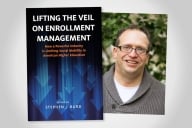You have /5 articles left.
Sign up for a free account or log in.

A College Signing Day celebration in Washington, D.C. was dampened by the fact that FAFSA delays have kept many students from making their college decisions.
Rich Kessler Photography
WASHINGTON, D.C. — For most college-bound high schoolers, May 1, the typical commitment deadline for most institutions, marks the end of a stressful admissions process. And on Tuesday, hundreds of local students, teachers and counselors crowded the rafters at Washington D.C.’s Capital One Arena to celebrate.
The College Signing Day event—put on by the D.C. College Access Program and its board chairman Ted Leonsis, who owns the arena—was outwardly revelrous. Former first lady Michelle Obama delivered the keynote address. Wizards power forward Anthony Gill high-fived the basketball team’s fuzzy blue mascot. Students waved #collegesigningday pennants and danced in their seats, happy to have a few hours away from class. Some wore college sweatshirts boasting their newfound pride in Towson, UDC, Case Western and Cornell.
But this year’s May 1 was not a typical college decision day, and not all students had something to celebrate.
Financial aid offers have been delayed by months thanks to the bungled rollout of the new Free Application for Federal Student Aid (FASFA), which has been plagued by a series of errors and missteps. The fiasco has held up college aid offers and mired students’ college decisions in limbo. Many institutions have pushed their commitment deadlines back to mid-May or June to compensate.
“They’re very tone deaf this year,” said Ashlie Savage, a college and career counselor at the Columbia Heights Educational Campus (CHEC), a bilingual grades 6 to 12 public school in northeast D.C., who attended the event with her students. She said that after spending untold hours this spring helping her college-bound seniors navigate issues with the new form, most are still waiting for their aid offers to come through before they can decide where to go.
“A lot of our students haven’t gotten their [Student Aid Index] numbers yet, they haven’t gotten their award letters, or they’ve gotten it back but it’s full of errors,” she said, looking around at the festivities. “Everything is wrong.”
In her keynote speech, Obama attempted to strike a balance between celebration and a recognition of this year’s unique challenges.
“I know it’s been a long, hard road to make it to this day. There’s nothing normal about the journey you’ve been on,” she told the students, recounting the first two years of high school they spent learning virtually because of Covid-19. Then she addressed the elephant in the room: “Even with some of the delays in the financial aid process, you made it.”
The problem is, not everyone has. The FAFSA delays have disproportionately affected low-income students who rely on federal aid, many of whom are still waiting on aid offers to make informed decisions about their options.

Michelle Obama was the keynote speaker at Tuesday’s College Signing Day event.
Alexander Vassiliadis Photography
The students in attendance at Capital One were almost entirely Black and Hispanic; the schools invited serve predominantly low-income populations, and many students who spoke to Inside Higher Ed would be first-generation college-goers.
“They should really understand their population better,” said Ana Carolina Massoni, another college and career coordinator at CHEC. “It’s been a really hard year for us.”
Last-Minute Fixes
A few blocks away, the Department of Education was working to make up for lost ground.
In a press call that morning, under secretary of education James Kvaal proudly proclaimed that the new federal aid system was, finally, up and running smoothly. Officials had finished reprocessing the roughly half-a-million forms marked by calculation errors, and had fixed a technical glitch that had locked families with mixed immigration status out of the form since its January launch. Most colleges, he said, had begun sending out aid forms.
“It’s been a challenging year for the FAFSA, but I’m proud of the progress we’ve made in recent weeks,” he said.
For counselors like Savage, that’s bittersweet news; the fixes are coming too late to allow students sufficient time to make fully informed college decisions. Massoni said that at CHEC, most of the large number of mixed-status students there hadn’t even filled out the FAFSA yet.
Other scholarships and grant programs have also been waylaid by the FAFSA delays. D.C. College Access Program president Eric Waldo said his organization has been able to award private scholarships but that the distribution of the D.C. Tuition Assistance Grants, the district’s version of state financial aid, has been held up because it’s tied to Pell eligibility.
The FAFSA issues have also led to major shortfalls in form completion rates this year. As of April 19, form completion was down by 29 percent, a gap that has narrowed slightly in recent weeks but has proven fairly intractable. College access advocates worry it could lead to the largest enrollment decline since Covid—or larger.
Last year, Savage’s school won an award for having the most FAFSA completions in the city. This year, only about 30 percent of CHEC’s graduating class of 250 has completed the form.
“That doesn’t even include those who have to go back and make corrections,” Savage said. “That’s been hell, too.”
Alexander Vassiliadis Photography
A Premature Celebration
May 1 doesn’t hold the sacrosanct place on the college admissions calendar that it used to—especially for colleges that serve lower-income students, where waitlists and spot-saving deposits are largely nonfactors.
“We recognize it’s not just about one day,” Waldo said. “We’re kicking off college signing season.”
Still, in a typical year College Signing Day is an important milestone for high school seniors.
That was certainly the case for Mikayla Kelley, a senior at Benjamin Banneker Academy who attended the College Signing Day event. She sported a shirt from Spelman College, where she’s headed in the fall to study public health advocacy, a calling she feels drawn to after years taking care of her disabled mother. She received a scholarship from DC-CAP, and was beaming from her appearance on the Capitol One stage, where she and other students announced their college commitments.

Mikayla Kelley, far right, committed to Spelman because of private scholarships that covered most of her tuition. She didn’t receive her federal aid estimate until April 29.
Alexander Vassiliadis Photography
Still, Mikayla’s decision was marred by the FAFSA fiasco. Weeks after submitting, she had to re-enter the form to correct an error: a missing signature. She said she couldn’t have completed the form without the help of two college counselors at Banneker, a magnet school to which she travels from her home in Anacostia, D.C.’s highest poverty neighborhood.
And while she was confident in her selection, she didn’t have much time to decide between Spelman and her other top choice, Temple University. She had only received her federal aid package the day before—on April 29, two weeks before Spelman and Temple’s extended May 15 commitment deadline. She said that without private scholarships, she wasn’t sure she could have afforded college at all.
“It was hard because of the new way they set it up,” she said. “With the FAFSA being delayed, I thought I’d have to delay my decision. But it all worked out, which I’m grateful for.”
Many students weren’t so lucky. Massoni said she’s been too focused on easing students’ stress around college decisions—which some are trying to make without accurate financial aid information—to celebrate those few who have made a commitment.
“I was helping a student out yesterday. She’s between two colleges and needs to see how much aid she’s going to get to determine what she chooses,” Massoni said. “She’s really scared because she doesn’t want to lose her spot. But she doesn’t know what else to do.”

A College Signing Day sign, scuffed by the day’s crowd underfoot. Many students left the event still unsure of their plans for the fall.
Photo by Liam Knox for Inside Higher Ed









